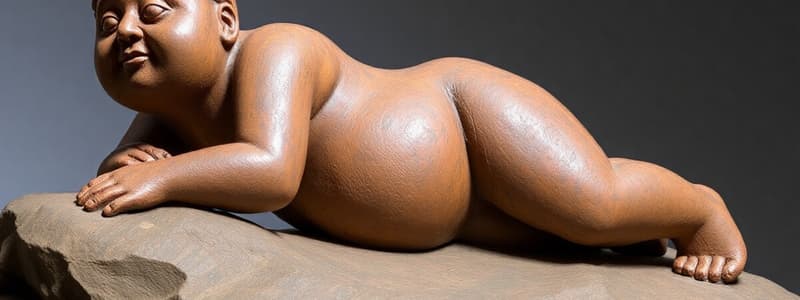Podcast
Questions and Answers
What is the significance of the Venus of Willendorf?
What is the significance of the Venus of Willendorf?
It was used as a charm to ensure fertility.
Where is the Venus of Brassempouy located?
Where is the Venus of Brassempouy located?
Musée d'Archéologie Nationale at Saint-Germain-en-Laye.
What materials were most commonly used for sculptures in ancient Egypt?
What materials were most commonly used for sculptures in ancient Egypt?
- Wood
- Ivory
- Stone
- All of the above (correct)
Queen Nefertiti was known for her _____ under her heavy crown.
Queen Nefertiti was known for her _____ under her heavy crown.
What is the characteristic style of Hellenistic sculpture?
What is the characteristic style of Hellenistic sculpture?
What is a sarcophagus?
What is a sarcophagus?
Roman sculptures aimed to compete with Greek free-standing works.
Roman sculptures aimed to compete with Greek free-standing works.
What themes are dominant in Byzantine sculptures?
What themes are dominant in Byzantine sculptures?
What is an example of a work from the Romanesque period?
What is an example of a work from the Romanesque period?
Flashcards are hidden until you start studying
Study Notes
Pre-Historic Sculptures
- Sculpture materials vary by region with natural elements often mistaken for art.
- Carvings may hold mythological or religious meanings.
Venus of Willendorf
- Date: 28,000 - 25,000 B.C.E.
- Carved from limestone, depicting exaggerated features symbolizing fertility.
Venus of Brassempouy
- Age: approximately 25,000 years.
- Fragmentary ivory figurine showcasing detailed human facial features and hairstyle, housed at Musée d'Archéologie Nationale.
Egyptian Era Sculptures
- Sculptures employed symbolic elements like hieroglyphics and gestures, extensively used in tombs.
- Common materials included wood, ivory, and stone.
Characteristics of Egyptian Sculptures
- Deities represented with animal heads and human bodies.
- Relief compositions often aligned horizontally to depict events.
- Scale hierarchy: gods larger than humans, kings larger than subjects, and the deceased larger than the living.
- Spaces filled with figures or hieroglyphics enhancing visual storytelling.
Queen Nefertiti
- Era: 18th Dynasty, 1375-1357 B.C.
- Realistic portrayal with distinctive features, made from painted limestone.
The Pharaoh Menkaure and his Queen
- Timeframe: 4th Dynasty, 2548-2530 B.C.E.
- Stone sculpture known for its rigid postures reflecting power and simplicity of emotion.
Western Classical Art Traditions
Greek Sculptures
- Early Greek pieces exhibited rigidity, with later works showing advanced anatomical understanding.
- Hellenistic style emphasized dynamic movement and elaborate figure arrangements.
Myron: The Discobulus
- Date: 450 B.C.
- Captures intense tension and impending action, representing classical ideals of athleticism.
Roman Sculptures
- Roman works primarily in monumental terra-cotta; reliefs on triumphal columns displayed narrative scenes.
The Portonacio Sarcophagus
- Date: 180-190 B.C.E.
- Elaborate sarcophagus depicting battles between Romans and Germans, used for the burial of a Roman General.
Monumental Terra-Cotta Sarcophagus
- Date: c. 520 B.C.E., housed in Museo Nazionale de Villa Giulia, Rome.
- Features a reclining husband and wife, conveying intimacy in funerary art.
Byzantine Sculptures
- Dominated by religious themes and motifs from nature, often symbolically represented through animals.
- Acrostic signs provided theological significance.
The Barberini Diptych
- Notable early example of Byzantine ivory craftsmanship.
Romanesque Sculptures
- Included reliquaries, altar frontals, and crucifixes; designed for royal and aristocratic patrons.
- Lightweight devotional images were crafted to be mobile and utilized in religious processions.
Studying That Suits You
Use AI to generate personalized quizzes and flashcards to suit your learning preferences.




